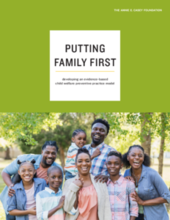Displaying 4271 - 4280 of 14138
This paper aims to provide a better understanding of the impact of parental migration on the welfare of left-behind children in the Philippines so that policies can be devised to support them.
Preliminary findings from studies using abbreviated formats of Parent-Child Interaction Therapy (PCIT) suggest effectiveness of such adaptations in reducing externalizing behavior in foster children and maintaining behavioral improvements several months after the end of the treatment.
This paper offers some insight into the benefits, impacts and challenges of the ‘creative mentor’ role. It links to a social pedagogy framework, supporting practice, and draws on creative mentors’ work with children and young people living in care. It aims to inform professionals and teams around a child about the transforming nature of working with creativity – beyond the obvious external experiences.
This multilevel meta-analysis compared the outcomes of Treatment Foster Care Oregon for Adolescents (TFCO-A) and home-based treatment programs (HBT) with residential youth care for children and youth aged 0 to 23 years.
This paper from the Annie E. Casey Foundation provides guidance for state child welfare agencies on what to consider when developing a preventive practice model that aligns with the requirements of Family First, addresses the unique needs of families within local communities and ensures that selected programs and practices are feasible to implement with quality.
For this study, one hundred and twenty‐six 11–21 year olds (53 who had experience of the care system and 73 who did not) were recruited from the community and NHS. All participants had self‐harmed in the past 6 months. Participants completed an Audio Computer‐Assisted Self‐interview (ACASI) regarding their views about the support they had received, how helpful it was, and what further help they felt they needed.
This article describes the different approaches taken by New York City and Los Angeles child welfare systems in light of the COVID-19 crisis.
"Hundreds of millions of children around the world will likely face increasing threats to their safety and wellbeing – including mistreatment, gender-based violence, exploitation, social exclusion and separation from caregivers – because of actions taken to contain the spread of the COVID-19 pandemic," said UNICEF in this 20 March press release.
New York City's child welfare agency is “'aggressively' hunting for space to house [foster] youth who are sick or who need to be moved away from ill caretakers," according to this article from the Chronicle of Social Change.
This framework represents Save the Children’s planning assumptions and priority areas for implementation over four phases of programming: Preparedness, Initial Response, Large-Scare Response, and Recovery.




